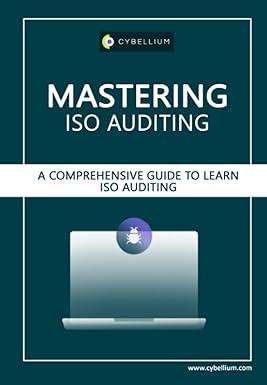Question
Navigating the Intricacies of the Accounting Balance Sheet: Components, Valuation, Financial Position Analysis, and Stakeholder Implications In the realm of financial accounting, the balance sheet
Navigating the Intricacies of the Accounting Balance Sheet: Components, Valuation, Financial Position Analysis, and Stakeholder Implications
In the realm of financial accounting, the balance sheet stands as a foundational financial statement that offers a comprehensive snapshot of an organization's financial position at a specific point in time. Can you provide an exhaustive examination of accounting balance sheets, beginning with a deep exploration of their fundamental concepts and objectives, elucidating how they serve as a vital tool for assessing the financial health, liquidity, and solvency of a company? How do balance sheets provide stakeholders with critical insights into an organization's assets, liabilities, and equity, facilitating informed investment decisions, credit assessments, and strategic planning?
Furthermore, the components of a balance sheet are multifaceted and interconnected, encompassing assets, liabilities, and equity. Can you dissect each of these components in detail, delineating their meanings, classifications, and calculation methodologies? How do current assets differ from non-current assets, and how does this distinction impact an organization's liquidity and operational flexibility? Likewise, what are the categories of liabilities, and how do they reflect the company's financial obligations and capital structure? Additionally, how is shareholders' equity calculated, and what does it represent in terms of ownership and financial cushion for creditors?
Valuation plays a pivotal role in ensuring the accuracy and reliability of balance sheet figures. Can you elucidate the principles governing the valuation of assets and liabilities, including the concept of fair value, historical cost, and the recognition of contingent liabilities? How do these valuation methods influence the reported financial position of a company, and how can they impact stakeholders' perceptions and decisions?
The balance sheet is not merely a financial document; it also serves as a critical tool for various stakeholders, including investors, creditors, and company management. Can you delve into how balance sheets assist investors in evaluating the financial stability, growth potential, and risk exposure of a company? How do creditors use balance sheets to assess an entity's creditworthiness and repayment capacity? Furthermore, how do company executives and management teams utilize balance sheets to make informed strategic decisions, manage working capital, and optimize capital allocation for sustainable growth and profitability?
In an era marked by technological advancements and data analytics, how are modern accounting practices leveraging technology to enhance the accuracy, timeliness, and predictive value of balance sheets? Can you elaborate on emerging trends, such as automation, cloud-based accounting software, and blockchain technology, and their impact on financial reporting and analysis? What are the challenges and opportunities presented by these technological innovations in the realm of balance sheets and financial management?
Lastly, with the growing emphasis on sustainability, environmental, social, and governance (ESG) considerations, how are companies incorporating ESG metrics into their balance sheets to provide a more comprehensive view of their financial performance, social impact, and environmental responsibility? How are stakeholders, including investors and regulators, responding to these developments in terms of investment decisions, corporate accountability, and regulatory compliance?
Step by Step Solution
There are 3 Steps involved in it
Step: 1

Get Instant Access to Expert-Tailored Solutions
See step-by-step solutions with expert insights and AI powered tools for academic success
Step: 2

Step: 3

Ace Your Homework with AI
Get the answers you need in no time with our AI-driven, step-by-step assistance
Get Started


